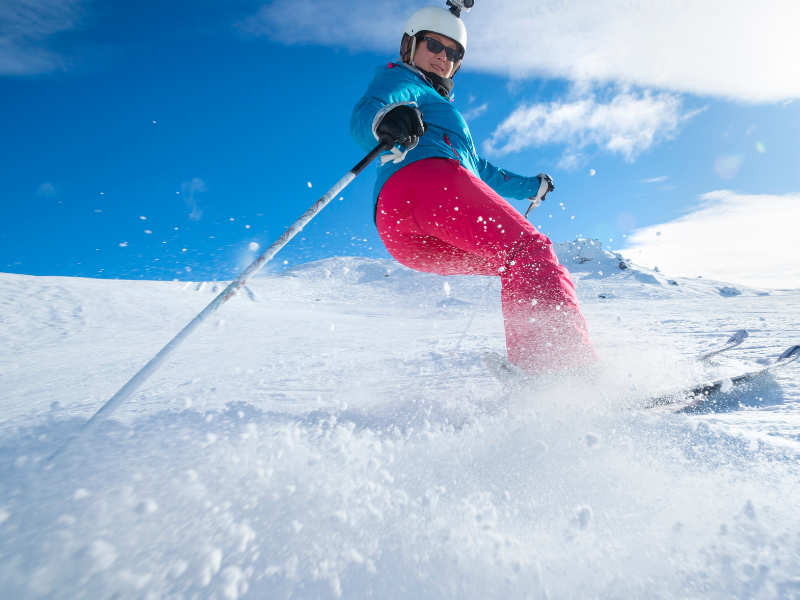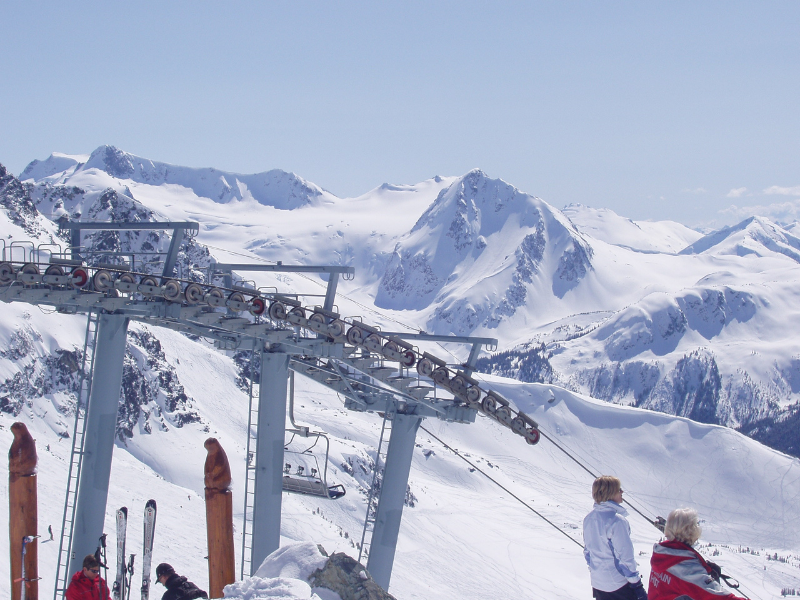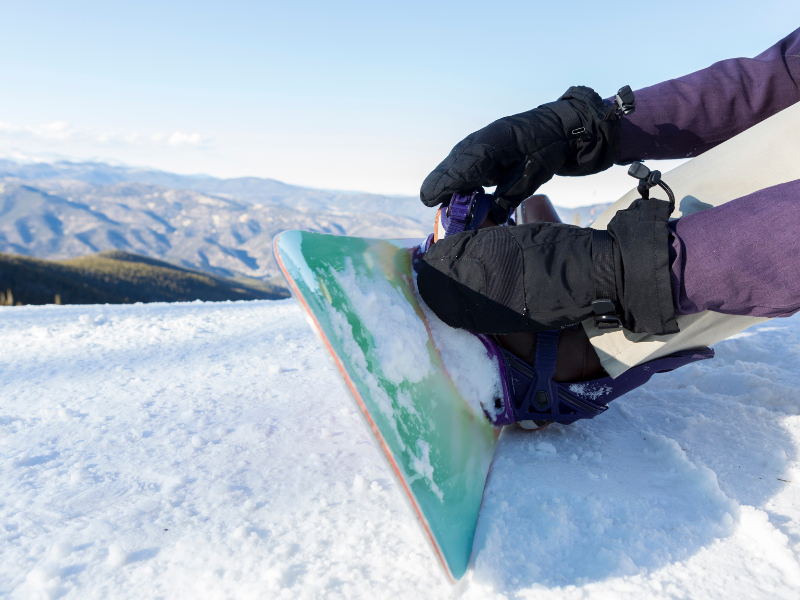Without fail, two types of friends go on the annual group ski and snowboard trip; the one who overpacked, and the one who packed for the wrong trip. With the surge in athleisure apparel over the past few years the slopes are now filled with the friend who packed for the wrong adventure. There's quite a bit of debate going around on one item in particular, and it's time to put it to rest once and for all - can you wear leggings skiing and snowboarding?
Wearing everyday leggings for skiing and snowboarding is highly discouraged, even as a layer. Most leggings lack moisture-wicking capabilities. Without this technical feature, leggings trap sweat and moisture inside, which will make the wearer colder and uncomfortable while skiing or snowboarding.
Technically you could wear everyday leggings, but you shouldn't. Leggings come in a variety of styles and technical capabilities, so there are some exceptions. If you're considering leggings as part of your layering system, there are four main technical features to know before you start packing. Let's have a look at each.
Check out Kenver's extensive selection of clothing:
Kenver's Clothing Collection
Top 4 Features To Consider in Your Leggings for Skiing
If you own one pair of leggings, you own a dozen; from several brands and in several styles. So it's hard to say whether one pair is good for the slopes or not.
Instead of listing out hundreds of brands and thousands of styles, after reading the following list, you'll know the must-have features any leggings need to have if they are going to be mountain appropriate.
1. Warmer And Thicker Isn't The Goal
You're going skiing or snowboarding, so naturally, you'd assume that you need a thick pair of leggings. But that's not always the case. In fact, in some instances, it's better to have a thinner pair of leggings.
For instance, if you're wearing a pair of insulated snow pants because the temperature is semi-cold, you may not need extra insulation from your leggings. In this case, a thinner pair of leggings would be better.
Or, if you're in a more temperate location and wearing uninsulated pants, a semi-thick pair of leggings could do the job.
All technical clothing for snow sports is about managing a comfortable temperature for a specific environment and activity. And since skiing or snowboarding is a cardio workout disguised as a fun activity, you're going to be generating heat.
If your leggings are too warm, they'll overheat your body, produce even more sweat, and soak your leggings with moisture that will quickly become cold and uncomfortable. This will ruin your day.
It's a bit of a catch-22 since the purpose of leggings is still to add a layer of warmth, but you'll need to gauge that as part of your entire system of pants and the climate of where you're headed to.
General Guide for Leggings Thickness:
- Long johns or thermal underwear equivalent - light enough, but add a little bit of warmth
- Thermal leggings over cotton leggings - always opt for a thermal blend legging - they are built for warmth and moisture-wicking (more on that in a second). Look for grading across lightweight, midweight, and heavyweight.
- Err on the side of thin - thicker leggings are going to reduce your mobility, so as a worst-case scenario in case you don't know which thickness to choose from, go thin. Extra mobility will assist in body warmth, plus you'll have a better experience this way.
- Climate impact - always take into account the conditions of your destination - temperature, the wetness of snow, wind, etc.
- Your body temp - If you're someone who runs hot, look into lightweight thermal leggings, and if you run cold, look into heavyweight thermal leggings.
None of the considerations above should be looked at in isolation. Picking the right leggings is all about balance. Weigh the climate, your body temp, and your clothing system together to find the appropriate thickness.
And if you don't know, grab a couple of thickness levels for your trip and err on the side of thin if you must.
2. The Right Fabric For The Job
If you're thinking of wearing cotton leggings, just don't. Seriously. Cotton is one of the worst materials you can wear as an inner layer when trying to stay warm skiing or snowboarding. Once it gets wet, which will happen, all of the moisture will absorb into the cotton and make you far colder.
The best type of fabric to look for when shopping for leggings is a synthetic material like polyester or nylon blend, or even merino wool, which will give you the soft and comfortable fit, flexibility, breathability, warmth, and moisture-wicking properties you need.
Flexibility is important here, you'll already have layers on, and layers are codeword for stiffness if done improperly. Something that bends and is lightweight is going to prevent your control of motion from getting bogged down.
So how do you pick the right fabric? Look at the tags on your leggings or if you're shopping, look at the product material description. Here are a few fibers/fabric materials to look for, either outright or as a blend in your leggings.
Best Fibers/Fabrics For Ski And Snowboard Leggings:
- Polypropylene
- Polyester (or recycled polyester)
- Nylon
- Merino Wool
- Microfibers (consisting of other fibers in this list)
3. Too Tight Equals Restricted Movement
The best leggings, even outside of snow sports, are once that fit "just right." Not too tight and not too loose.
The same rules apply to snow sports - you don't want leggings to be so tight that they're uncomfortable or cutting off circulation, but you also don't want them to be so baggy that they're not wicking moisture or retaining the right amount of heat.
Your leggings should be form-fitting - and if you opt for the materials in the list above, many are constructed for multi-directional stretch. Making them ideal for all the movement your body does while skiing and snowboarding.
Not sure if your leggings are too tight for skiing and snowboarding? No worries, follow the three steps below.
Three Ways To Tell If Thermal Leggings Fit Correctly:
- Squat, twist, and touch your toes: Seriously, put your leggings on and do a squat. Twist from side to side like you're in jazzercise. And finally, either standing or sitting with your legs stretched out, can you touch your toes or at least the distance you can normally reach? If you did all three of these and it didn't feel like you were suffocating or in pain, your leggings are not too tight. On to the next test.
- Can you see your skin? The best way to do this test is to grab a mirror, and either perform a squat or any sort of exercise that stresses how much your leggings can stretch in a certain area. If you can see skin, your leggings aren't the right fit. Fun fact, this is called "grinning" - when your skin shows through the fabric while it's being stretched.
- Any overhang in the front? Muffin tops are natural, but if you see an excess of your body hanging over the front of your leggings, it's time to size up.
Your leggings for skiing and snowboarding are simply a layer that keeps your body at the right temp and dry, plus nobody is going to see them on you. So don't go tight as a fashion statement, it's only going to restrict your body movement.
4. Moisture Control Is A Must For Your Leggings
Nothing like saving the best for last, and in this case, moisture control is also a must-have feature. It's been touched on throughout this article because it's so important, but your leggings should absolutely be made to handle moisture.
Moisture control, or moisture management, consists of two components. Pushing moisture away from your body (that's a nice way of saying sweat) and preventing moisture from getting to your body (usually this is snow.)
When picking leggings, you'll need to find a pair that says moisture-wicking, which is responsible for pulling moisture away from your body. Here's a quick look at the two components of moisture management.
The Two Components of Moisture Management:
- Moisture-wicking: Moisture-wicking is when a fabric is designed to pull sweat away from your skin and body - pushing it to the exterior.
- Water-resistance or waterproofed: Water-resistance means that fabric can resist some water penetration, while waterproofed means it completely stops water from seeping in.
For skiing and snowboarding, focus on handling moisture-wicking with your leggings. You should let your other layers, especially your shell handle water resistance or be waterproof.
Managing your moisture levels is important for comfort as well as safety. When you're cold and wet, your body is more susceptible to hypothermia. So do yourself a favor and make sure your leggings can handle moisture - whether it's from the snow or your body heat.
The Most Common Questions About Leggings And Snow Sports
Even after telling someone that their gym leggings aren't going to do the job while skiing, that doesn't stop the questions. You or your friends might be similar, in that case, here are some of the more common questions asked about leggings for skiing and snowboarding.
Why Is It Important To Choose The Right Leggings?
It's all about sweat. When you do any kind of physical activity, your body sweats - in skiing or snowboarding, that sweat needs a place to go, and it's going to be leggings if you're wearing them. This means you'll be wet and ultimately cold, which can lead to discomfort or even getting sick.
Additionally, if you don’t choose the right skiwear, and your fabric is too restricting, that can lead to further injury. Going down a rugged mountain at 25mph can be dangerous, being able to move your body as you intend isn't just a nice-to-have, it's a must.
Why Can’t I Wear Cotton Leggings?
Normal cotton fabrics or everyday cotton fabrics aren't made for the conditions you'll face on a mountain. That's not to say cotton doesn't have a place, in fact, you'll probably find cotton as part of a fabric blend in your snow getup, but it's rarely the primary fabric for any activity on the slopes.
Cotton will store the sweat you build up while skiing or snowboarding which can make you feel a lot colder. Sweating is your body’s way of cooling down, however, in the winter, you don't want the sweat to cool you down. Cotton is the opposite of what you want in this case.
Can You Wear Yoga Pants While Skiing or Snowboarding?
Yoga pants can be an alternative to leggings when skiing, however, the same rules apply to yoga pants as they do to leggings. Temperature control, moisture-wicking, comfort, flexibility, etc. Seeing a theme here?
Can I Wear Layers Under Leggings?
The two-layer approach is often suggested for the bottom half of skiwear, however, you do have the option to wear layers under or over the leggings. Everybody is different, so if you think you will be cold you can wear an extra layer under your leggings.
Some people even wear two leggings in super cold conditions.
If this is the case, you will want to make sure you size your leggings right so that they fit with multiple layers without restricting you.
So Yes, You Can Wear Leggings, But Only Certain Types
Now that you know how to choose the right leggings for your next group ski trip, you’ll stay dry and comfortable out there.
When you shop for your ski apparel, always choose what feels best, and what you think will pair best with the climate. If you follow the techniques above, we're sure you’ll find the perfect leggings for your trip.
Check out Kenver's extensive selection of clothing:
Kenver's Clothing Collection



